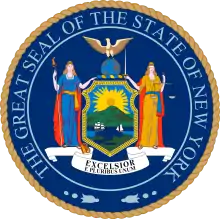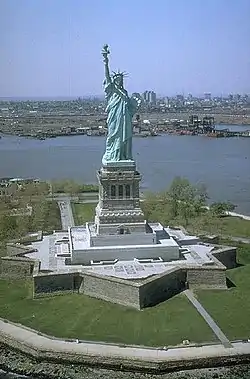Orange County, New York
Orange County is a county located in the U.S. state of New York. As of the 2010 census, the population was 372,813.[2] The county seat is Goshen.[3] This county was first created in 1683 and reorganized with its present boundaries in 1798.[4]
Orange County | |
|---|---|
 Island Pond in Harriman State Park, near the Village of Harriman. | |
 Flag .png.webp) Seal | |
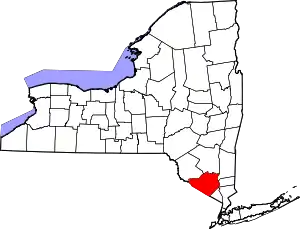 Location within the U.S. state of New York | |
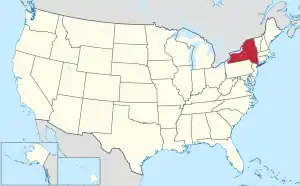 New York's location within the U.S. | |
| Coordinates: 41°24′N 74°19′W | |
| Country | |
| State | |
| Founded | 1683/1698 |
| Named for | William III of Orange |
| Seat | Goshen |
| Largest town | Warwick |
| Government | |
| • County Executive | Steven M. Neuhaus |
| Area | |
| • Total | 839 sq mi (2,170 km2) |
| • Land | 812 sq mi (2,100 km2) |
| • Water | 27 sq mi (70 km2) 3.2% |
| Population | |
| • Estimate (2019) | 384,940[1] |
| • Density | 474.1/sq mi (183.1/km2) |
| Time zone | UTC−5 (Eastern) |
| • Summer (DST) | UTC−4 (EDT) |
| Congressional district | 18th |
| Website | www |
Orange County is part of the Poughkeepsie–Newburgh–Middletown metropolitan statistical area,[5] which belongs to the larger New York–Newark–Bridgeport, NY–NJ–CT–PA Combined Statistical Area. It is in the state's Mid-Hudson Region of the Hudson Valley Area.
The County Executive is Steve Neuhaus.
As of the 2010 census the center of population of New York state was located in Orange County, approximately three miles west of the hamlet of Westbrookville.[6]
History
Orange County was officially established on November 1, 1683, when the Province of New York was divided into twelve counties. Each of these was named to honor a member of the British royal family, and Orange County took its name from the Prince of Orange, who subsequently became King William III of England. As originally defined, Orange County included only the southern part of its present-day territory, plus all of present-day Rockland County further south. The northern part of the present-day county, beyond Moodna Creek, was then a part of neighbouring Ulster County.
At that date, the only European inhabitants of the area were a handful of Dutch colonists in present-day Rockland County, and the area of modern Orange County was entirely occupied by the native Munsee people. Due to its relatively small population, the original Orange County was not fully independent and was administered by New York County.
The first European settlers in the area of the present-day county arrived in 1685. They were a party of around twenty-five families from Scotland, led by David Toshach, the Laird of Monzievaird, and his brother-in-law Major Patrick McGregor, a former officer of the French Army. They settled in the Hudson Highlands at the place where the Moodna Creek enters the Hudson River, now known as New Windsor. In 1709, a group of German Palatine refugees settled at Newburgh. They were Protestants from a part of Germany along the Rhine that had suffered during the religious wars. Queen Anne's government arranged for passage from England of nearly 3,000 Palatines in ten ships. Many were settled along the Hudson River in work camps on property belonging to Robert Livingston. A group of Dutch and English settlers arrived at Goshen in 1712. Additional immigrants came from Ireland; they were of Scots and English descent who had been settled as planters there.
During the American Revolutionary War the county was a hotbed of Loyalist and anti-Patriot activity. Claudius Smith was a Loyalist marauder whose team robbed and terrorized citizens; he was hanged in Goshen in 1779 for allegedly robbing and killing Major Nathaniel Strong; two of his sons were also executed for similar crimes. The Mathews family of Blooming Grove were active Loyalists; Fletcher Mathews was a sympathizer and sometime associate of Smith,[7] and his brother David Mathews was Mayor of New York City during its British occupation for the entirety of the war.
In 1798, after the American Revolutionary War, the boundaries of Orange County changed. Its southern corner was used to create the new Rockland County, and in exchange, an area to the north of the Moodna Creek was added, which had previously been in Ulster County. This caused a reorganization of the local administration, as the original county seat had been fixed at Orangetown in 1703, but this was now in Rockland County. Duties were subsequently shared between Goshen, which had been the center of government for the northern part of Orange County, and Newburgh, which played a similar role in the area transferred from Ulster County. The county court was established in 1801. It was not until 1970 that Goshen was named as the sole county seat.
Due to a boundary dispute between New York and New Jersey, the boundaries of many of the southern towns of the county were not definitively established until the 19th century.[8]
Geography
According to the U.S. Census Bureau, the county has a total area of 839 square miles (2,170 km2), of which 812 square miles (2,100 km2) is land and 27 square miles (70 km2) (3.2%) is water.[9]
Orange County is in southeastern New York State, directly north of the New Jersey-New York border, west of the Hudson River, east of the Delaware River and northwest of New York City. It borders the New York counties of Dutchess, Putnam, Rockland, Sullivan, Ulster, and Westchester, as well as Passaic and Sussex counties in New Jersey and Pike County in Pennsylvania.
Orange County is the only county in New York State which borders both the Hudson and Delaware Rivers.
Orange County is where the Great Valley of the Appalachians finally opens up and ends. The western corner is set off by the Shawangunk Ridge. The area along the Rockland County border (within Harriman and Bear Mountain state parks) and south of Newburgh is part of the Hudson Highlands. The land in between is the valley of the Wallkill River. In the southern portion of the county the Wallkill valley expands into a wide glacial lake bed known as the Black Dirt Region for its fertility.
The highest point is Schunemunk Mountain, at 1,664 feet (507 m) above sea level. The lowest is sea level along the Hudson.
National protected areas
Adjacent counties
- Dutchess County – northeast
- Passaic County, New Jersey - southeast
- Pike County, Pennsylvania – southwest
- Putnam County - east
- Rockland County – southeast
- Sullivan County – northwest
- Sussex County, New Jersey - south
- Ulster County – north
Demographics
| Historical population | |||
|---|---|---|---|
| Census | Pop. | %± | |
| 1790 | 18,492 | — | |
| 1800 | 29,355 | 58.7% | |
| 1810 | 34,347 | 17.0% | |
| 1820 | 41,213 | 20.0% | |
| 1830 | 45,336 | 10.0% | |
| 1840 | 50,739 | 11.9% | |
| 1850 | 57,145 | 12.6% | |
| 1860 | 63,812 | 11.7% | |
| 1870 | 80,902 | 26.8% | |
| 1880 | 88,220 | 9.0% | |
| 1890 | 97,859 | 10.9% | |
| 1900 | 103,859 | 6.1% | |
| 1910 | 116,001 | 11.7% | |
| 1920 | 119,844 | 3.3% | |
| 1930 | 130,383 | 8.8% | |
| 1940 | 140,113 | 7.5% | |
| 1950 | 152,255 | 8.7% | |
| 1960 | 183,734 | 20.7% | |
| 1970 | 221,657 | 20.6% | |
| 1980 | 259,603 | 17.1% | |
| 1990 | 307,647 | 18.5% | |
| 2000 | 341,367 | 11.0% | |
| 2010 | 372,813 | 9.2% | |
| 2019 (est.) | 384,940 | [10] | 3.3% |
| U.S. Decennial Census[11] 1790-1960[12] 1900-1990[13] 1990-2000[14] 2010-2019[2] | |||
2000-2010
At the 2010 United States Census, there were 372,813 people living in the county. The population density was 444 people per square mile (171/km2). The racial makeup of the county was 77.2% White, 10.2% Black or African American, 0.5% Native American, 2.4% Asian, and 3.1% from two or more races. 18% of the population were Hispanic or Latino of any race.[15] According to the 2000 United States Census, 18.3% were of Italian, 18.1% English, 17.4% Irish, 10.2% German, and 5.0% Polish ancestry. According to the 2009–13 American Community Survey, 76.57% of people spoke only English at home, 13.39% spoke Spanish, 4.03% spoke Yiddish, and 0.83% spoke Italian.[16]
During the 2000 Census, there were 114,788 households, out of which 39.60% had children under the age of 18 living with them, 57.90% were married couples living together, 11.40% had a female householder with no husband present, and 26.40% were non-families. 21.50% of all households were made up of individuals, and 8.50% had someone living alone who was 65 years of age or older. The average household size was 2.85 and the average family size was 3.35.
In the county, the population was spread out, with 29.00% under the age of 18, 8.70% from 18 to 24, 30.00% from 25 to 44, 21.90% from 45 to 64, and 10.30% who were 65 years of age or older. The median age was 35 years. For every 100 females, there were 100.30 males. For every 100 females age 18 and over, there were 97.50 males.
The median income for a household in the county was $52,058, and the median income for a family was $60,355. Males had a median income of $42,363 versus $30,821 for females. The per capita income for the county was $21,597. About 7.60% of families and 10.50% of the population were below the poverty line, including 14.80% of those under age 18 and 8.00% of those age 65 or over.
Despite its rural roots, Orange County has been among the fastest-growing regions within the New York City metropolitan area.[17]
2018
Per the American Community Survey's 2018 estimates, there were 381,951 residents within Orange County.[18] 63.5% of the county was non-Hispanic white, 12.95 Black or African American, 0.8% Native American, 2.9% Asian, 0.1% Pacific Islander, 3.0% from two or more races, and 21.0% Hispanic or Latino of any race. 24.4% of Orange County's residents spoke another language other than English at home.
There were 126,776 households in 2018 and an average of 2.90 persons per household. The owner-occupied housing rate was 68.0% and the median gross rent of the county was $1,223. The median homeowner cost with a mortgage was $2,280 and $909 without a mortgage.
The median income for a household from 2014-2018 was $76,716 and the per capita income was $33,472. 11.5% of the county's inhabitants were below the poverty line in 2018.
Law and government
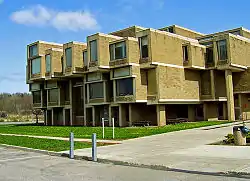
Originally, like most New York counties, Orange County was governed by a board of supervisors. Its board consisted of the 20 town supervisors, nine city supervisors elected from the nine wards of the City of Newburgh, and four each elected from the wards of the cities of Middletown and Port Jervis. In 1968, the board adopted a county charter and a reapportionment plan that created the county legislature and executive. The first county executive and legislature were elected in November, 1969 and took office on January 1, 1970. Today, Orange County is still governed by the same charter; residents elect the county executive and a 21-member county legislature elected from 21 single-member districts. There are also several state constitutional positions that are elected, including a sheriff, county clerk and district attorney. Prior to 1 January 2008 four coroners were also elected; however, on that date, the county switched to a medical examiner system.
The current county officers are:
- County Executive: Steven M. Neuhaus (Republican)
- County Clerk: Annie Rabbit (Republican)
- Sheriff: Carl E. DuBois (Republican)
- District Attorney: David M. Hoovler (Republican)
The County Legislature and its previous board of supervisors were long dominated by the Republican Party. However, since the late 20th century, the Democrats have closed the gap. During 2008 and 2009 the legislature was evenly split between 10 Republicans, 10 Democrats, and 1 Independence Party member. In 2009, the legislature had its first Democratic chairman elected when one member of the Republican caucus voted alongside the 10 Democratic members to elect Roxanne Donnery (D-Highlands/Woodbury) to the post. At the November 2009 election, several Democratic incumbents were defeated. As of the convening of the legislature on January 1, 2012, there are 12 Republicans, 8 Democrats, and 1 Independence member.
| Name | Party | Term |
|---|---|---|
| Louis V. Mills | Republican | January 1, 1970 – December 31, 1977 |
| Louis C. Heimbach | Republican | January 1, 1978 – December 31, 1989 |
| Mary M. McPhillips | Democratic | January 1, 1990 – December 31, 1993 |
| Joseph G. Rampe | Republican | January 1, 1994 – December 31, 2001 |
| Edward A. Diana | Republican | January 1, 2002 – December 31, 2013 |
| Steven M. Neuhaus | Republican | January 1, 2014 – Present |
| District | Legislator | Party | Residence |
|---|---|---|---|
| 1 | Michael Amo | Independence | Central Valley |
| 2 | Janet Sutherland | Republican | |
| 3 | Paul Ruszkiewicz | Republican | Pine Island |
| 4 | Kevindaryán Luján | Democratic | Newburgh |
| 5 | Katie Bonelli majority leader | Republican | Blooming Grove |
| 6 | James M. Kulisek | Democratic | |
| 7 | Peter Tuohy | Republican | |
| 8 | Barry J. Cheney | Republican | Warwick |
| 9 | L. Stephen Brescia chairman | Republican | Montgomery |
| 10 | John S. Vero | Republican | Chester |
| 11 | Kathy Stegenga | Republican | |
| 12 | Kevin Hines | Republican | Cornwall |
| 13 | Thomas J. Faggione | Republican | Deerpark |
| 14 | Laurie R. Tautel | Democratic | |
| 15 | Joseph J. Minuta | Republican | |
| 16 | Leigh J. Benton | Republican | Newburgh |
| 17 | Mike Anagnostakis | Republican | Maybrook |
| 18 | Rob Sassi | Republican | |
| 19 | Michael D. Paduch minority leader | Democratic | Middletown |
| 20 | Joel Sierra | Democratic | Middletown |
| 21 | James D. O'Donnell | Republican |
In 1970, the county switched from government by a Board of Supervisors, consisting of the elected heads of town governments, to having a 21-member elected county legislature and executive. The sheriff, district attorney and county clerk have always been elected. All serve four-year terms, with elections in the year following presidential election years, save the sheriff, whose election is the following year.
The current county executive is Steven Neuhaus, former town supervisor for Chester. David M. Hoovler, Annie Rabbitt and Carl DuBois are the incumbent district attorney, clerk and sheriff respectively. All are Republicans.
Only one Democrat, Mary McPhillips, has served as county executive. She failed to win re-election after a single term in the early 1990s. For several years in the late 2000s, one Republican legislator's decision to become an independent and caucus with the Democrats led to a 10-10-1 effective Democratic majority, with Roxanne Donnery as chair. The Republicans regained their majority in the 2009 elections.
Transportation

The county is served by Stewart International Airport, located two miles west of Newburgh, New York. The airport serves American Airlines, Delta Air Lines, Allegiant Air, and JetBlue Airways. AirTran Airways stopped providing service to the airport in late 2008.
Ground transportation within Orange County is provided primarily by Leprechaun Lines, Monsey Trails, NJ Transit, Short Line Bus, and Metro-North Railroad's Port Jervis Line, as well as amenities such as senior citizen busing and car services, which usually restrict themselves to their respective town or city.[19][20]
Major routes in Orange County are freeways Interstate 84, Interstate 87, State Route 17 (Future Interstate 86), and the Palisades Interstate Parkway, and surface roads U.S. Route 6, U.S. Route 9W, and U.S. Route 209. There are two Hudson River crossings in Orange County: the Bear Mountain Bridge and the Newburgh-Beacon Bridge.
Politics
| Year | Republican | Democratic | Third parties |
|---|---|---|---|
| 2020 | 49.4% 84,996 | 49.2% 84,684 | 1.5% 2,516 |
| 2016 | 50.4% 76,645 | 44.9% 68,278 | 4.7% 7,098 |
| 2012 | 46.5% 65,367 | 52.1% 73,315 | 1.4% 1,946 |
| 2008 | 47.4% 72,042 | 51.5% 78,326 | 1.1% 1,614 |
| 2004 | 54.7% 79,089 | 43.8% 63,394 | 1.5% 2,190 |
| 2000 | 49.7% 62,852 | 46.0% 58,170 | 4.4% 5,535 |
| 1996 | 40.1% 45,956 | 48.0% 54,995 | 11.9% 13,587 |
| 1992 | 43.7% 53,493 | 37.5% 45,946 | 18.8% 23,081 |
| 1988 | 62.4% 65,446 | 36.7% 38,465 | 0.9% 899 |
| 1984 | 67.8% 69,413 | 31.9% 32,663 | 0.3% 337 |
| 1980 | 56.7% 51,268 | 33.2% 30,022 | 10.1% 9,180 |
| 1976 | 54.8% 49,685 | 44.5% 40,362 | 0.7% 626 |
| 1972 | 71.0% 63,556 | 28.8% 25,778 | 0.2% 181 |
| 1968 | 56.1% 44,955 | 35.1% 28,122 | 8.8% 7,072 |
| 1964 | 38.8% 30,610 | 61.1% 48,244 | 0.1% 70 |
| 1960 | 60.7% 48,646 | 39.3% 31,471 | 0.1% 65 |
| 1956 | 77.5% 57,739 | 22.5% 16,722 | 0.0% 0 |
| 1952 | 71.2% 51,217 | 28.6% 20,585 | 0.1% 98 |
| 1948 | 62.8% 38,351 | 33.8% 20,638 | 3.3% 2,042 |
| 1944 | 61.7% 39,041 | 38.0% 24,059 | 0.3% 162 |
| 1940 | 58.4% 38,913 | 41.4% 27,632 | 0.2% 145 |
| 1936 | 54.4% 34,428 | 43.5% 27,528 | 2.1% 1,320 |
| 1932 | 56.4% 30,687 | 42.2% 22,971 | 1.4% 765 |
| 1928 | 64.1% 37,334 | 32.7% 19,047 | 3.2% 1,859 |
| 1924 | 67.7% 29,184 | 22.7% 9,765 | 9.6% 4,134 |
| 1920 | 66.1% 24,558 | 28.5% 10,567 | 5.4% 2,010 |
| 1916 | 56.1% 13,619 | 42.0% 10,198 | 2.0% 478 |
| 1912 | 43.1% 10,364 | 39.1% 9,404 | 17.7% 4,258 |
| 1908 | 57.0% 14,414 | 39.3% 9,938 | 3.7% 924 |
| 1904 | 56.9% 14,222 | 39.6% 9,882 | 3.5% 879 |
| 1900 | 57.1% 14,137 | 41.1% 10,180 | 1.8% 432 |
| 1896 | 59.5% 14,086 | 37.9% 8,971 | 2.6% 610 |
| 1892 | 48.7% 11,081 | 45.8% 10,421 | 5.5% 1,252 |
| 1888 | 49.5% 11,261 | 47.7% 10,852 | 2.8% 640 |
| 1884 | 48.3% 9,968 | 47.7% 9,841 | 4.0% 822 |
In recent years, Orange County has mirrored the preferences of the nation as a whole in presidential elections, voting for the winner in every election from 1996 to 2016. The streak ended in 2020, however, as Orange County narrowly voted to re-elect Donald Trump, even as Democratic nominee Joe Biden of Delaware won the election overall.
Bill Clinton won Orange County 48% to 42% in 1996. George W. Bush won 47% of the Orange County vote in 2000, and 54% in 2004. Barack Obama carried the county with a 51% vote share four years later and carried the county again in 2012. However, Donald Trump won the county in 2016, thus making it one of 206 counties across the country to vote for Obama twice and then Trump. In 2020, Trump again won Orange County, this time by just 312 votes out of nearly 170,000 votes cast, a margin of about 0.2 percentage points. Despite this, it was only the fourth-closest county in the state and one of five that Trump won by less than 500 votes.
Previously, like most of the Lower Hudson, Orange County had leaned Republican. From 1884 to 1992, a Republican carried Orange County at all but one presidential election. The only time this tradition was broken was in 1964, during Democrat Lyndon Johnson's 44-state landslide. As a measure of how Republican the county was, Franklin Roosevelt, a resident of nearby Dutchess County, failed to carry Orange County in any of his four successful presidential bids.
The presidential election results give the county a Cook PVI of R+1, consistent with county voters' willingness to sometimes elect Democrats, such as U.S. Rep. John Hall. From 2007 on, when Hall represented the 19th district, which covered most of the county, Orange's representation in Congress was exclusively Democratic, as Maurice Hinchey had represented the towns of Crawford, Montgomery, and Newburgh as well as the city of Newburgh, all of which were in what was then the 22nd district, since 1988.
In the 2010 midterms, Hall was defeated by Nan Hayworth. In 2012, after Hinchey's former 22nd district was eliminated in redistricting following his retirement and all of Orange County was included in the current 18th district. Hayworth was defeated by Democrat Sean Patrick Maloney, a former adviser to President Bill Clinton and the first openly gay person to be elected to Congress from New York.[22] Maloney won a rematch against Hayworth in 2014; in 2016 he was again re-elected over Phil Oliva, and in 2018, despite running in the Democratic primary for New York Attorney General, he won re-election again over James O'Donnell.
At the state level, Republicans had held onto Senate seats (until 2018) while Democrats have made inroads in recent years on the Assembly side. Two State Senate districts—the 39th, held by James Skoufis and 42nd, held by Jen Metzger—cover the county.
Democrats have made significant gains in the county's State Assembly seats. The 98th district, which includes the far western part of the county as well as the Town of Warwick, is represented by Karl Brabenec, and the 101st district, which includes the Towns of Crawford and Montgomery, was until 2016 held by Claudia Tenney, both Republicans. After Tenney left her seat to run for Congress that year, Brian D. Miller, another Republican, was elected to replace her. Colin Schmitt represents the 99th district, while the other two are Democrats: Aileen Gunther in the 100th district and Jonathan Jacobson in the 104th district.
Sports
Delano-Hitch Stadium in Newburgh has played host to various professional and amateur baseball teams from various leagues since opening in 1926. The stadium is currently home to the Newburgh Newts.
High school sports
High schools in Orange County compete in Section 9 of the New York State Public High School Athletic Association along with schools from Dutchess, Ulster, and Sullivan counties.
College sports
The Army Black Knights of the United States Military Academy in West Point field NCAA Division I teams in 24 different sports. Mount Saint Mary College in Newburgh fields 15 teams in the Eastern College Athletic Conference and the Skyline Conference of NCAA Division III. Orange County Community College Colts in Middletown compete in the National Junior College Athletic Association.
Communities
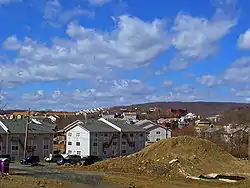
Towns
Villages
Census-designated places
In popular culture
- Heavy: Port Jervis
- Super Troopers: parts of the movie were filmed in the Newburgh area.
- The Sopranos parts of season 6-b, Episode 1: Warwick and Tuxedo[24]
- Michael Clayton: Moodna Viaduct (Cornwall), South Blooming Grove, and Stewart Airport (New Windsor/Newburgh area)[25]
- The Human Footprint: parts filmed in the Hudson Valley region; aired on National Geographic Channel in 2008[26]
- American Chopper: Montgomery, NY
- Final Destination 1& 2: Parts of plot takes place in Otisville, NY and Greenwood Lake, NY - Shown by patches that police officers wear and television news program that is played.
- The OA: Partially filmed in Central Valley, NY[27]
Points of interest
Points of interest in Orange County include the United States Military Academy at West Point; Brotherhood Winery, America's oldest winery, in Washingtonville; the birthplace of William H. Seward in Florida; the home and birthplace of Velveeta and Liederkranz Cheese in Monroe; the Harness Racing Museum & Hall of Fame in Goshen; the Times Herald-Record newspaper, the first cold press offset daily in the country, in Middletown; the Galleria at Crystal Run, in Wallkill; the Woodbury Common Premium Outlets in Monroe; and the Orange County Fair in Wallkill. The only state parks include Goosepond Mountain State Park, Harriman State Park and Sterling Forest State Park. It is also the location of Orange County Choppers, the custom motorcycle shop featured on The Discovery Channel television series American Chopper.

Middletown 
Newburgh 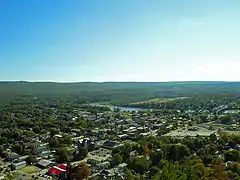
Port Jervis 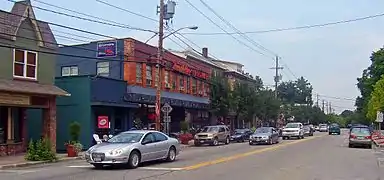
Florida 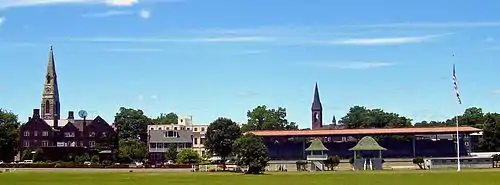
Goshen 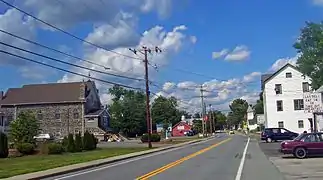
Maybrook 
Monroe 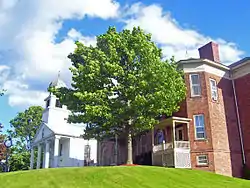
Montgomery 
Walden 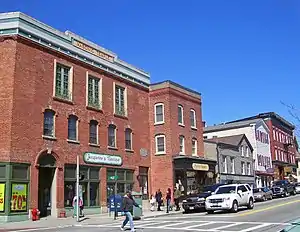
Warwick 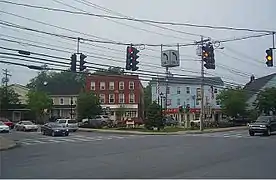
Washingtonville 
Woodbury
Notable residents
- Sarah Wells, settler 1600s, Chester/Goshen area, matriarch of the Bull family
- James Dolson, settler 1600s, beaver-pelt trader
- Bette, emanumated slave 1700s, Historical diarist
- George Washington, 1st President of the United States, leader of the American Revolutionary War, from April 1782 until August 1783.[28][29]
- Benedict Arnold, revolutionary war general and traitor
- William Seward, U.S. Secretary of State, under Lincoln, born & raised Florida.[30][31]
- Henry Wisner, Orange County delegate to the First and Second Continental Congress
- David Mathews, Loyalist Mayor of New York City under the British during the American Revolution, may have been born but also lived in Mathewsfield (now Blooming Grove)
- Noah Webster, Goshen teacher, lexicographer, author
- J. Hector St. John de Crèvecœur, 18th century writer, author of Letters from an American Farmer
- Elizabeth Marie Pope, author of The Sherwood Ring
- Stephen Crane, author of The Red Badge of Courage
- Pierre Lorillard, tobacco magnate
- Emily Post, author
- Tomás Estrada Palma, first President of Cuba, lived in a home on Route 32 in Central Valley.
- David Moffat, railroad developer, Washingtonville native
- Webb Horton, industrial tanner, early 20th Century, built Webb Horton House & WH church Middletown
- Babe Ruth, summered at Glenmere Mansion
- Solomon Townsend, industrialist and State Legislator
- Rose Thompson Hovick, mother of Gypsy Rose Lee and June Havoc
- Jolie Gabor mother of Gabor sisters, resided Goshen, NY
- Frank Shorter, 1972 Olympic Marathon gold medalist
- Emily DiDonato, fashion model, spokesmodel for Maybelline
- General David Petraeus, Retired four-star general of the U.S. Army. Former Director of the C.I.A. and commander of U.S. forces in Iraq.[32]
- William Moran, a retired United States Navy Admiral and Vice-Chief of Naval Operations (2016-2019).
- Mel Gibson, attended school in Washingtonville the year before his family moved to Australia in the 1960s.[33]
- Nathaniel White, convicted serial killer
- Geraldine Ferraro, 1984 U.S. Vice-Presidential candidate, U.S. Congresswoman
- Benjamin Gilman, US Congressman, 1973-2003, lifelong Middletown resident
- Jay Westervelt, environmentalist
- Joel Teitelbaum, Grand Rabbi of Satmar Hasidic community, spent final years and is buried in Kiryas Joel
- Aaron Teitelbaum, current Grand Rabbi of Kiryas Joel faction of Satmar Hasidic community.
- Jimmy Sturr, 18x Grammy winning, polka musician
- Andy Grammer, musician
- Brad Mehldau, jazz pianist
- James Patterson, author
- Al Sarrantonio, author
- Spencer Tunick, photographer
- Tony Gilroy, writer, producer, director.[34]
- Willie the Lion Smith, stride jazz pianist
- Denzel Washington actor, attended the now defunct Oakland Military Academy
- Whoopi Goldberg, Academy Award-winning actress, Tuxedo Park
- Robert DeNiro Academy Award-winning actor, home in Tuxedo Park
- James Cromwell actor 1970s-2020s, political & environmental activist, resides Warwick, NY
- Cyndi Lauper, 80s pop singer, spent summers in Tuxedo Park
- Marisa Anderson, celebrity & Police/CID 'psychic'
- James Mangold, screenwriter, director.[34]
- Armand Assante, actor
- Barry Bostwick, actor
- Johnny Brennan - Washingtonville resident in 1990s, comedian/actor The Jerky Boys, Family Guy (voices Mort)
- Saul Williams, musician, poet, actor and artist; was born and raised in Newburgh
- Paul Teutul Sr., reality TV star, owner Orange County Choppers
- Paul Teutul Jr., custom motorcycle builder of Paul Jr. Designs
- Derek Jeter, New York Yankees captain, purchased Tiedemann Castle in Warwick[35][36]
- Greg Anthony, former New York Knicks NBA player
- Tim Hummel, former MLB player Cincinnati Reds.
- Mike Avilés, baseball player for the Kansas City Royals and Boston Red Sox, raised Middletown
- Matt Morris, former all star pitcher St. Louis Cardinals and Pittsburgh Pirates, Valley Central graduate
- Joe Nathan, MLB player for the Minnesota Twins and Texas Rangers[37]
- Dee Brown, former Major League Baseball and Nippon Professional Baseball player.[38]
- Rob Bell, former MLB pitcher.[39]
- Jason Motte, former MLB pitcher, closer for the 2011 Champion St. Louis Cardinals, Valley Central graduate
- Dave Telgheder, former MLB pitcher for the New York Mets and the Oakland Athletics.[40]
- Brian Cashman, General Manager, New York Yankees
- Scott Pioli, NFL executive, former General Manager of the Kansas City Chiefs[41]
- Vérité, musician
- Cage Kennylz, rapper, raised in Middletown
- Aaron Tveit, actor/singer, Broadway star, reared in Middletown
See also
References
- https://www.census.gov/quickfacts/fact/table/orangecountynewyork/PST045216
- "State & County QuickFacts". United States Census Bureau. Archived from the original on July 28, 2011. Retrieved October 12, 2013.
- "Find a County". National Association of Counties. Archived from the original on May 3, 2015. Retrieved 2011-06-07.
- "New York: Individual County Chronologies". New York Atlas of Historical County Boundaries. The Newberry Library. 2008. Retrieved January 10, 2015.
- United States Office of Management and Budget (14 September 2018). "OMB Bulletin No. 18-04" (PDF). Retrieved 11 July 2019.
- "Center of population of New York as of 2010 census (Google Maps)". Retrieved July 5, 2016.
- Public Papers of George Clinton, First Governor of New York, 1777-1795, 1801-1804. 1900, page 634
- Headly, Russel, (1908), The History of Orange County New York, Skeel, Adelaide, and Barclay, David, (1900), Major Patrick MacGregorie, Green, Frank Bertangue, (1886), The History of Rockland County.
- "2010 Census Gazetteer Files". United States Census Bureau. August 22, 2012. Archived from the original on May 19, 2014. Retrieved January 6, 2015.
- "Population and Housing Unit Estimates". Retrieved March 26, 2020.
- "U.S. Decennial Census". United States Census Bureau. Archived from the original on April 26, 2015. Retrieved January 6, 2015.
- "Historical Census Browser". University of Virginia Library. Retrieved January 6, 2015.
- "Population of Counties by Decennial Census: 1900 to 1990". United States Census Bureau. Retrieved January 6, 2015.
- "Census 2000 PHC-T-4. Ranking Tables for Counties: 1990 and 2000" (PDF). United States Census Bureau. Retrieved January 6, 2015.
- "QuickFacts - Orange County, New York". www.census.gov. United States Census Bureau. Retrieved 25 February 2017.
- "Detailed Languages Spoken at Home and Ability to Speak English". www.census.gov. United States Census Bureau. Retrieved 25 February 2017.
- Urban Action Agenda (2015). Changing Hudson Valley - Population Trends (PDF). Hudson Valley Pattern for Progress.
- "U.S. Census Bureau QuickFacts: Orange County, New York". www.census.gov. Retrieved 2020-02-01.
- "COMMUTER BUS SERVICE". Transit Orange. Orange County. Retrieved 2015-11-29.
- "Commuter Bus - Newburgh, Beacon & Stewart". Leprechan Lines. Archived from the original on 2015-12-08. Retrieved 2015-11-29.
- Leip, David. "Dave Leip's Atlas of U.S. Presidential Elections". uselectionatlas.org. Retrieved 2018-10-23.
- Bolcer, Julie (7 November 2013). "Gay Congressional Winner Makes History in New York". Advocate.com. Retrieved 8 July 2013.
- AirPods
- Rothman, Robin A.; Tomcho, Sandy (9 April 2007). "'Sopranos' hits the Hudson Valley again". Times Herald-Record. Retrieved 8 July 2013.
- Michael Clayton (2007) - Trivia - IMDb
- Lussier, Germain (13 April 2008). "State budget brings films back to N.Y." Times Herald-Record. Retrieved 8 July 2013.
- "M-W shines during filming of "The OA"". Monroe-Woodbury Central School District. Retrieved 6 January 2017.
- "Washington's Headquarters State Historic Site". New York State Parks Department.
- "Survey of Historic Sites and Buildings. Washington's Headquarters (Hasbrouck House)". National Park Service. Retrieved 10 October 2012.
- Glyndon G. Van Deusen, "The Life and Career of William Henry Seward 1801-1872"
- "Biographies of the Secretaries of State: William Henry Seward". U.S. Dept. of State, Office of the Historian. Retrieved 10 October 2012.
- "David H. Petraeus". Central Intelligence Agency. Archived from the original on October 19, 2011. Retrieved 4 October 2012.
- "Hudson Valley Magazine".
- Washingtonville Grads at Oscars
- Genovese, Peter (January 2012). "Hidden New Jersey: Greenwood Lake". The Star-Ledger. Retrieved 3 October 2012.
- "Tiedemann Castle". dupontcastle.com. Retrieved 3 October 2012.
- "Joe Nathan". Baseball-Reference.com. Retrieved 3 October 2012.
- "Dee Brown". Baseball-Reference.com. Retrieved 3 October 2012.
- "Rob Bell". Baseball-Reference.com. Retrieved 3 October 2012.
- "Dave Telgheder". Baseball-Reference.com. Retrieved 3 October 2012.
- Scott Pioli Bio
External links
| Wikimedia Commons has media related to Orange County, New York. |
| Wikivoyage has a travel guide for Orange County (New York). |
- Orange County, New York government
- Orange County tourism information
- Orange County, New York, Chamber of Commerce
- Orange County at Curlie
- Early summary history of Orange County
- Hudson Valley Directory, listings pertaining to Orange County, New York

